Stochastic Forecasting of Regional Age-Specific Fertility Rates: An Outlook for German NUTS-3 Regions
Abstract
1. Introduction
1.1. Background and Motivation
1.2. Regional Aspects of Fertility in Germany
2. Materials and Methods
2.1. Data Source and Preparation
2.2. Model Choice by Backtesting
- Greeks: the parameters estimated based on the 1996–2008 data via OLS;
- : the value of in year y;
- the year 1996.
2.3. Stochastic Forecast Approach
- : the simulation matrix of the logit-DASFRs for year y in trajectory t;
- : the simulation matrix of PCs for year y in trajectory t;
- : the inverse of the loading matrix.
- : the simulated logit-DASFR for females in age group a living in district d at the end of year y in trajectory t;
- : the simulated DASFR for females in age group a living in district d at the end of year y in trajectory t.
3. Results
4. Discussion
Supplementary Materials
Author Contributions
Funding
Data Availability Statement
Acknowledgments
Conflicts of Interest
Abbreviations
| ASFR | Age-specific fertility rate |
| CFR | Cohort fertility rate |
| DASFR | District- and age-specific fertility rate |
| NUTS | Nomenclature des unités territoriales statistiques |
| OLS | Ordinary least squares |
| PC(A) | Principal component (analysis) |
| PI | Prediction interval |
| Symmetric mean absolute percentage error of Model m | |
| TFR | Total fertility rate |
Appendix A. German Federal States
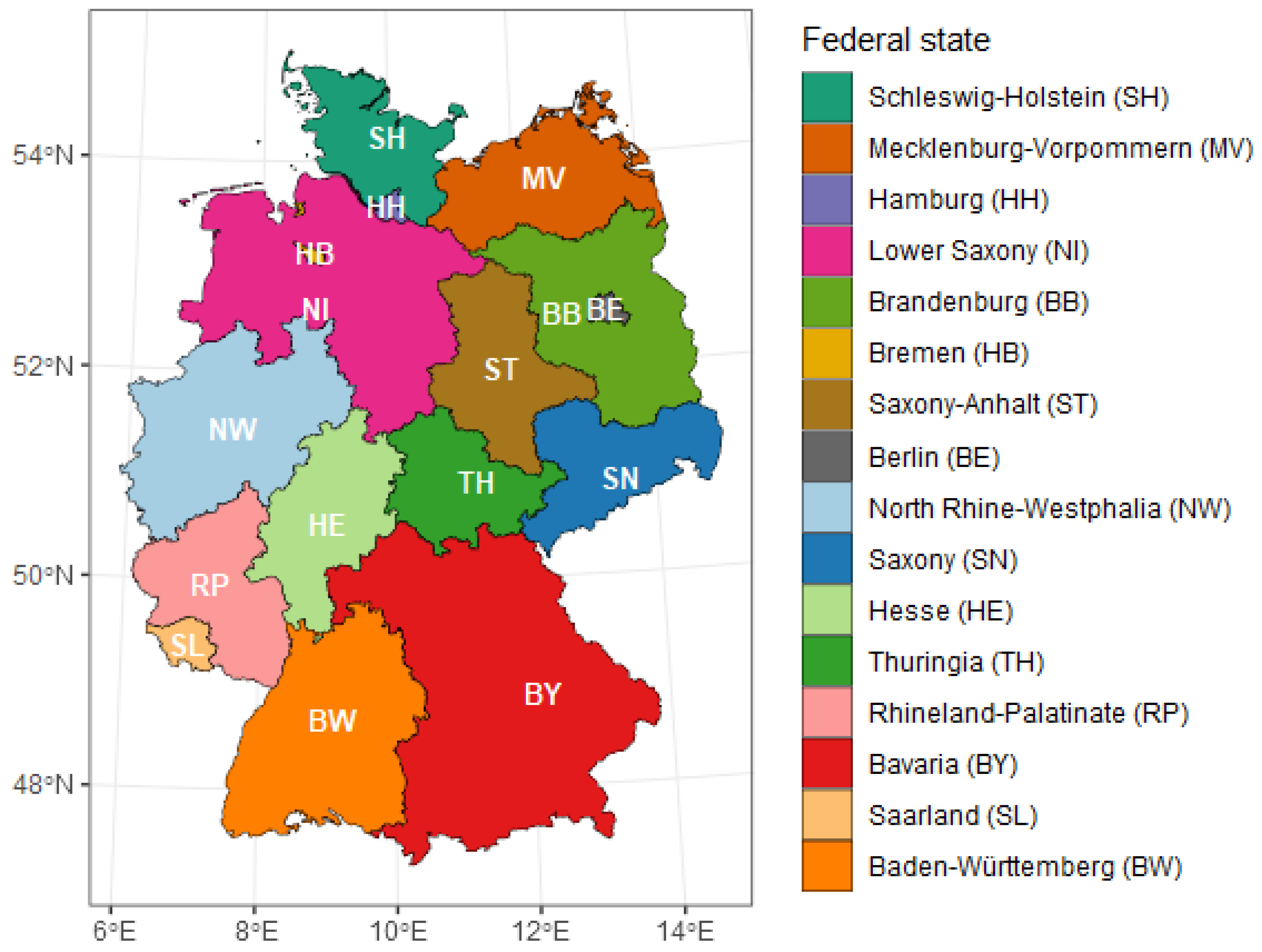
References
- Vanella, P.; Deschermeier, P. A Principal Component Simulation of Age-Specific Fertility—Impacts of Family and Social Policy on Reproductive Behavior in Germany. Popul. Rev. 2019, 58, 78–109. [Google Scholar] [CrossRef]
- Fuchs, J.; Söhnlein, D.; Weber, B.; Weber, E. Stochastic Forecasting of Labor Supply and Population: An Integrated Model. Popul. Res. Policy Rev. 2018, 37, 33–58. [Google Scholar] [CrossRef] [PubMed]
- Vanella, P.; Rodriguez Gonzalez, M.; Wilke, C.B. Population Ageing and Future Demand for Old-Age and Disability Pensions in Germany—A Probabilistic Approach. Comp. Popul. Stud. 2022, 47, 87–118. [Google Scholar] [CrossRef]
- Vanella, P.; Wilke, C.B.; Söhnlein, D. Prevalence and Economic Costs of Absenteeism in an Aging Population—A Quasi-Stochastic Projection for Germany. Forecasting 2022, 4, 371–393. [Google Scholar] [CrossRef]
- Vanella, P.; Heß, M.; Wilke, C.B. A probabilistic projection of beneficiaries of long-term care insurance in Germany by severity of disability. Qual. Quant. 2020, 54, 943–974. [Google Scholar] [CrossRef]
- Bomsdorf, E.; Babel, B.; Schmidt, R. Zur Entwicklung der Bevölkerung, der Anzahl der Schüler, der Studienanfänger und der Pflegebedürftigen. Sozialer Fortschr. (German Rev. Soc. Policy) 2008, 10, 943–974. [Google Scholar]
- Deschermeier, P.; Henger, R. Wie viel Wohnfläche benötigen wir? Vergangene und zukünftige Trends beim Wohnflächenkonsum—Empirische Evidenz und stochastische Prognose bis 2030. In Zur Relevanz von Bevölkerungsvorausberechnungen für Arbeitsmarkt-, Bildungs- und Regionalpolitik. IAB-Bibliothek 372; Deschermeier, P., Fuchs, J., Iwanow, I., Wilke, C.B., Eds.; wbv Media: Bielefeld, Germany, 2020; pp. 178–201. [Google Scholar]
- Lappegard, T.; Klüsener, S.; Vignoli, D. Why are marriage and family formation increasingly disconnected across Europe? A multilevel perspective on existing theories. Popul. Space Place 2018, 24, e2088. [Google Scholar] [CrossRef]
- Matysiak, A.; Sobotka, T.; Vignoli, D. The Great Recession and Fertility in Europe: A Sub-national Analysis. Eur. J. Popul. 2021, 37, 29–64. [Google Scholar] [CrossRef]
- Ebeling, M.; Rau, R.; Sander, N.; Kibele, E.; Klüsener, S. Urban–rural disparities in old-age mortality vary systematically with age: Evidence from Germany and England & Wales. Public Health 2022, 205, 102–109. [Google Scholar] [CrossRef]
- Vanella, P.; Hellwagner, T.; Deschermeier, P. Parsimonious Stochastic Forecasting of International and Internal Migration on the NUTS-3 level—An Outlook of Regional Depopulation Trends in Germany. Vienna Yearb. Popul. Res. 2023, 21, 361–415. [Google Scholar] [CrossRef]
- Basten, S.; Huinink, J.; Klüsener, S. Spatial Variation of Sub-national Fertility Trends in Austria, Germany and Switzerland. Popul. Space Place 2011, 36, 573–614. [Google Scholar] [CrossRef]
- Campisi, N.; Kulu, H.; Mikolai, J.; Klüsener, S.; Myrskylä, M. Spatial variation in fertility across Europe: Patterns and determinants. Popul. Space Place 2020, 26, e2308. [Google Scholar] [CrossRef]
- Bujard, M. Consequences of Enduring Low Fertility—A German Case Study. Demographic Projections and Implications for Different Policy Fields. Comp. Popul. Stud. 2015, 40, 131–164. [Google Scholar] [CrossRef]
- Williamson, L.; Norman, P. Developing strategies for deriving small population fertility rates. J. Popul. Res. 2011, 28, 129–148. [Google Scholar] [CrossRef][Green Version]
- Brzozowska, Z.; Zhelenkova, E.; Gietel-Basten, S. Population decline: Towards a rational, scientific research agenda. Vienna Yearb. Popul. Res. 2023, 21, 1–11. [Google Scholar] [CrossRef]
- Bujard, M.; Scheller, M. Impact of Regional Factors on Cohort Fertility: New Estimations at the District Level in Germany. Comp. Popul. Stud. 2017, 42, 55–88. [Google Scholar] [CrossRef]
- Maretzke, S.; Hoymann, J.; Schlömer, C.; Stelzer, A. Raumordnungsprognose 2040—Bevölkerungsprognose: Ergebnisse und Methodik; BBSR-Analysen KOMPAKT: Bonn, Germany, 2021. [Google Scholar]
- Vanella, P.; Greil, A.L.; Deschermeier, P. Fertility Response to the COVID-19 Pandemic in Developed Countries—On Pre-pandemic Fertility Forecasts. Comp. Popul. Stud. 2023, 48, 19–46. [Google Scholar] [CrossRef]
- Ševčíková, H.; Raftery, A.E.; Gerland, P. Probabilistic projection of subnational total fertility rates. Demogr. Res. 2018, 38, 1843–1884. [Google Scholar] [CrossRef]
- Camiz, S.; Pillar, V.D. Identifying the Informational/Signal Dimension in Principal Component Analysis. Mathematics 2018, 6, 269. [Google Scholar] [CrossRef]
- Vanella, P.; Deschermeier, P. A Probabilistic Cohort-Component Model for Population Forecasting—The Case of Germany. J. Popul. Ageing 2020, 13, 513–545. [Google Scholar] [CrossRef]
- Vanella, P.; Deschermeier, P.; Wilke, C.B. An Overview of Population Projections—Methodological Concepts, International Data Availability, and Use Cases. Forecasting 2020, 2, 346–363. [Google Scholar] [CrossRef]
- Deschermeier, P. Population Development of the Rhine-Neckar Metropolitan Area:A Stochastic Population Forecast on the Basis of Functional Data Analysis. Comp. Popul. Stud. 2012, 36, 769–806. [Google Scholar] [CrossRef]
- Wilson, T.G.; Grossman, I.; Alexander, M.; Rees, P.; Temple, J. Methods for Small Area Population Forecasts: State-of-the-Art and Research Needs. Popul. Res. Policy Rev. 2022, 41, 865–898. [Google Scholar] [CrossRef]
- Stadt Köln. Bevölkerungsprognose für Köln 2022 bis 2050. Mit kleinräumigen Berechnungen bis 2035; Kölner Statistische Nachrichten; Stadt Köln: Köln, Germany, 2022. [Google Scholar]
- Destatis. Bevölkerung im Wandel: Annahmen und Ergebnisse der 14. Koordinierten Bevölkerungsvorausberechnung. 2019. Available online: https://www.destatis.de/DE/Presse/Pressekonferenzen/2019/Bevoelkerung/pressebroschuere-bevoelkerung.pdf (accessed on 16 November 2023).
- Alkema, L.; Raftery, A.E.; Gerland, P.; Clark, S.J.; Pelletier, F.; Büttner, T.; Heilig, G.K. Probabilistic Projections of the Total Fertility Rate for All Countries. Demography 2011, 48, 815–839. [Google Scholar] [CrossRef]
- Rafael Caro-Barrera, J.; de los Baños García-Moreno García, M.; Pérez-Priego, M. Projecting Spanish fertility at regional level: A hierarchical Bayesian approach. PLoS ONE 2022, 17, e0275492. [Google Scholar] [CrossRef]
- Yang, Y.; Shang, H.L.; Raymer, J. Forecasting Australian fertility by age, region, and birthplace. Int. J. Forecast. 2022. [Google Scholar] [CrossRef]
- Jasilioniene, A.; Jdanov, D.A.; Sobotka, T.; Andreev, E.M.; Zeman, K.; Shkolnikov, V.M.; Goldstein, J.R.; Nash, E.J.; Philipov, D.; Rodriguez, G. Methods Protocol for the Human Fertility Database. 2015. Available online: https://www.humanfertility.org/File/GetDocumentFree/Docs/methods.pdf (accessed on 2 November 2023).
- Schmertmann, C.; Zagheni, E.; Goldstein, J.R.; Myrskylä, M. Bayesian Forecasting of Cohort Fertility. J. Am. Stat. Assoc. 2014, 109, 500–513. [Google Scholar] [CrossRef]
- Max Planck Institute for Demographic Research (Germany); Vienna Institute of Demography (Austria). West Germany, Period Total Fertility Rates and Period Total Fertility Rates by Age 40. 2023. Available online: https://www.humanfertility.org/Country/Country?cntr=DEUTW (accessed on 17 November 2023).
- Max Planck Institute for Demographic Research (Germany); Vienna Institute of Demography (Austria). East Germany, Period Total Fertility Rates and Period Total Fertility Rates by Age 40. 2023. Available online: https://www.humanfertility.org/Country/Country?cntr=DEUTE (accessed on 17 November 2023).
- Statistische Ämter des Bundes und der Länder. 12612–93-01-4: Lebendgeborene nach Alter der Mütter—Jahressumme—Regionale Tiefe: Kreise und krfr. Städte. 2023. Available online: https://www.regionalstatistik.de/genesis/onlineoperation=table&code=12612-93-01-4#astructure (accessed on 18 July 2023).
- Statistische Ämter des Bundes und der Länder. 12411–02-03-4: Bevölkerung nach Geschlecht und Altersgruppen (17)—Stichtag 31.12.—Regionale Tiefe: Kreise und krfr. Städte. 2023. Available online: https://www.regionalstatistik.de/genesis//online?operation=table&code=12411-02-03-4#astructure (accessed on 1 June 2023).
- Püschel, O. Religion und Glauben im Blickpunkt des Zensus 2011. Stat. Monatshefte Niedersachs. 2014, 2014, 395–404. [Google Scholar]
- Bundesinstitut für Bau-, Stadt- und Raumforschung. Privateinkommen, Private Schulden: Medianeinkommen. 2023. Available online: https://www.inkar.de/ (accessed on 15 November 2023).
- Bundesinstitut für Bau-, Stadt- und Raumforschung. SDG-Indikatoren für Kommunen: Betreuungsquote Kleinkinder. 2023. Available online: https://www.inkar.de/ (accessed on 15 November 2023).
- Destatis. Qualitätsbericht zur Statistik der Geburten: 2021–2022. 2023. Available online: https://www.destatis.de/DE/Methoden/Qualitaet/Qualitaetsberichte/Bevoelkerung/geburten.pdf (accessed on 12 December 2023).
- Hassenstein, M.J.; Vanella, P. Data Quality–Concepts and Problems. Encyclopedia 2022, 2, 498–510. [Google Scholar] [CrossRef]
- Destatis. Fortschreibung des Bevölkerungsstandes: Qualitätsbericht 2017. 2019. Available online: https://www.destatis.de/DE/Methoden/Qualitaet/Qualitaetsberichte/Bevoelkerung/bevoelkerungsfortschreibung-2017.pdf (accessed on 12 December 2023).
- Wickham, H.; Averick, M.; Bryan, J.; Chang, W.; McGowan, L.D.; François, R.; Grolemund, G.; Hayes, A.; Henry, L.; Hester, J.; et al. Welcome to the tidyverse. J. Open Source Softw. 2019, 4, 1686. [Google Scholar] [CrossRef]
- Wickham, H. ggplot2: Elegant Graphics for Data Analysis; Springer-Verlag: New York, NY, USA, 2016. [Google Scholar]
- Pebesma, E. Simple Features for R: Standardized Support for Spatial Vector Data. R J. 2018, 10, 439–446. [Google Scholar] [CrossRef]
- Pebesma, E.; Bivand, R. Spatial Data Science: With Applications in R; Chapman and Hall/CRC: Boca Raton, FL, USA, 2023. [Google Scholar] [CrossRef]
- Venables, W.N.; Ripley, B.D. Modern Applied Statistics with S, 4th ed.; Springer: New York, NY, USA, 2002; ISBN 0–387-95457-0. [Google Scholar]
- Trapletti, A.; Hornik, K.; LeBaron, B. Package ‘tseries’. 2023. Available online: https://cran.r-project.org/web/packages/tseries/tseries.pdf (accessed on 13 December 2023).
- Canty, A.; Ripley, B.D. boot: Bootstrap R (S-Plus) Functions; R Package Version 1.3-28.1; R Core Team: Vienna, Austria, 2022. [Google Scholar]
- Davison, A.C.; Hinkley, D.V. Bootstrap Methods and Their Applications; Cambridge University Press: Cambridge, UK, 1997; ISBN 0-521-57391-2. [Google Scholar]
- Hamner, B.; Frasco, M.; LeDell, E. Package ’Metrics’: Evaluation Metrics for Machine Learning. 2022. Available online: https://cran.r-project.org/web/packages/Metrics/Metrics.pdf (accessed on 13 December 2023).
- Wartburgstadt Eisenach. Fusion der Stadt Eisenach mit dem Wartburgkreis. 2021. Available online: https://www.eisenach.de/rathaus/fusion-der-stadt-eisenach (accessed on 28 July 2023).
- Brownlee, J. Machine Learning Mastery: Understand Your Data, Create Accurate Models and Work Projects End-to-End; Jason Brownlee: Melbourne, Australia, 2016. [Google Scholar]
- Hyndman, R.J.; Athanasopoulos, G. Forecasting: Principles and Practice; OTexts: Melbourne, Australia, 2018. [Google Scholar]
- Kroese, D.P.; Brereton, T.; Taimre, T.; Botev, Z.I. Why the Monte Carlo method is so important today. WIREs Comput. Stat. 2014, 6, 386–392. [Google Scholar] [CrossRef]
- Vanella, P. A principal component model for forecasting age- and sex-specific survival probabilities in Western Europe. German J. Risk Insur. 2018, 106, 539–554. [Google Scholar] [CrossRef]
- International Union for the Scientific Study of Population. The Total Fertility Rate. 2023. Available online: http://papp.iussp.org/sessions/papp101_s04/PAPP101_s04_080_010.html (accessed on 21 November 2023).
- Bujard, M. Wirkungen von Familienpolitik auf die Geburtenentwicklung. In Handbuch Bevölkerungssoziologie; Niephaus, Y., Kreyenfeld, M., Sackmann, R., Eds.; Springer Fachmedien: Wiesbaden, Germany, 2015; pp. 619–646. [Google Scholar]
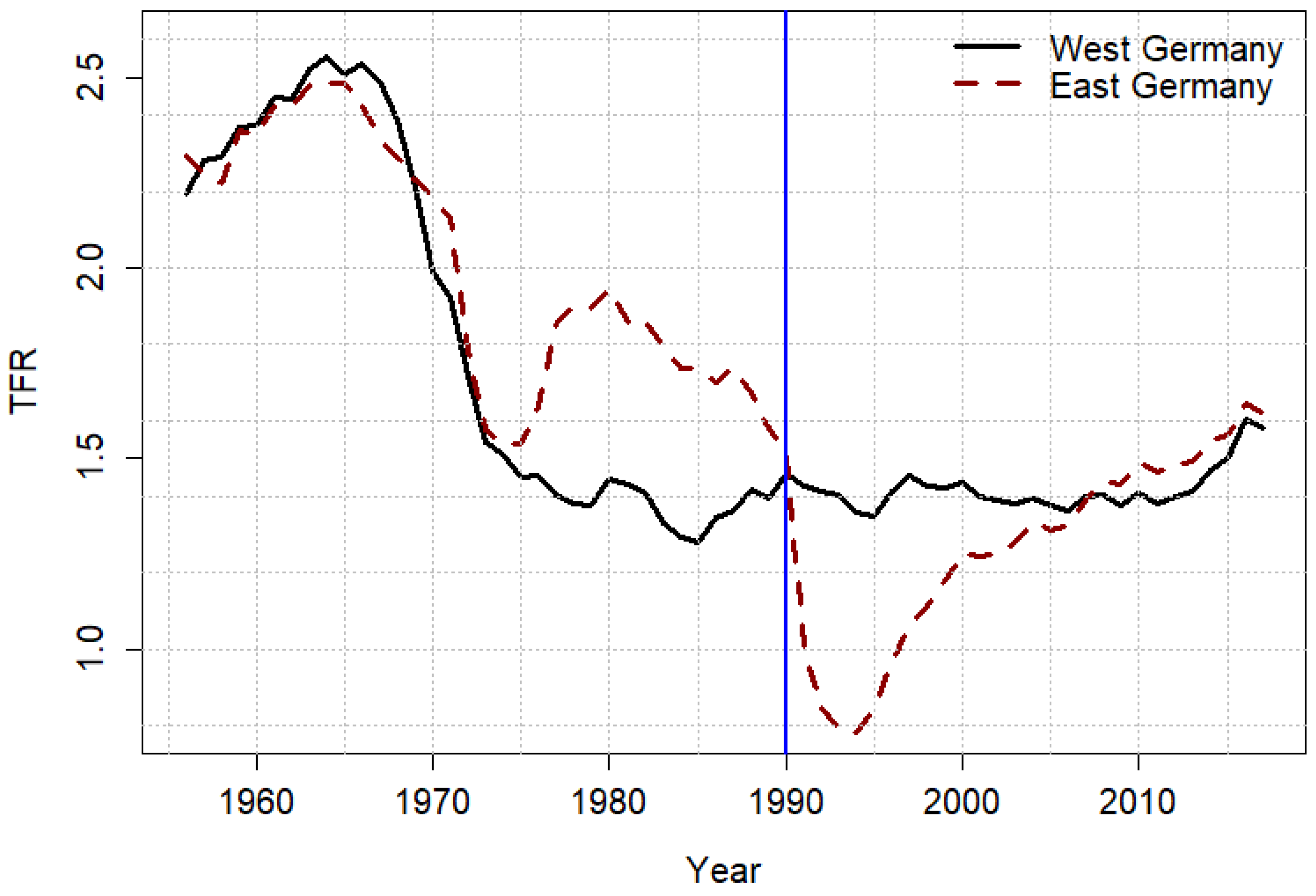

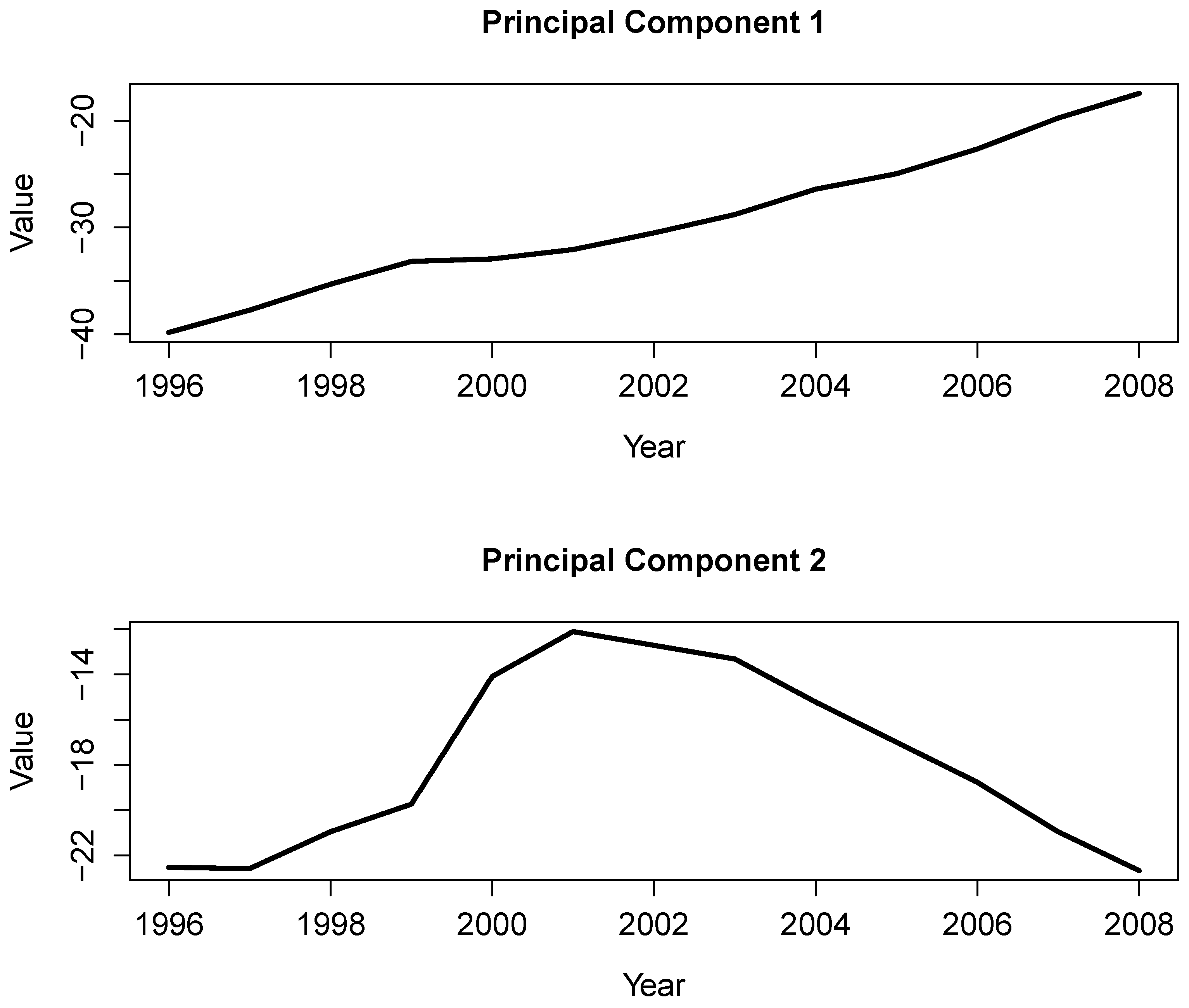

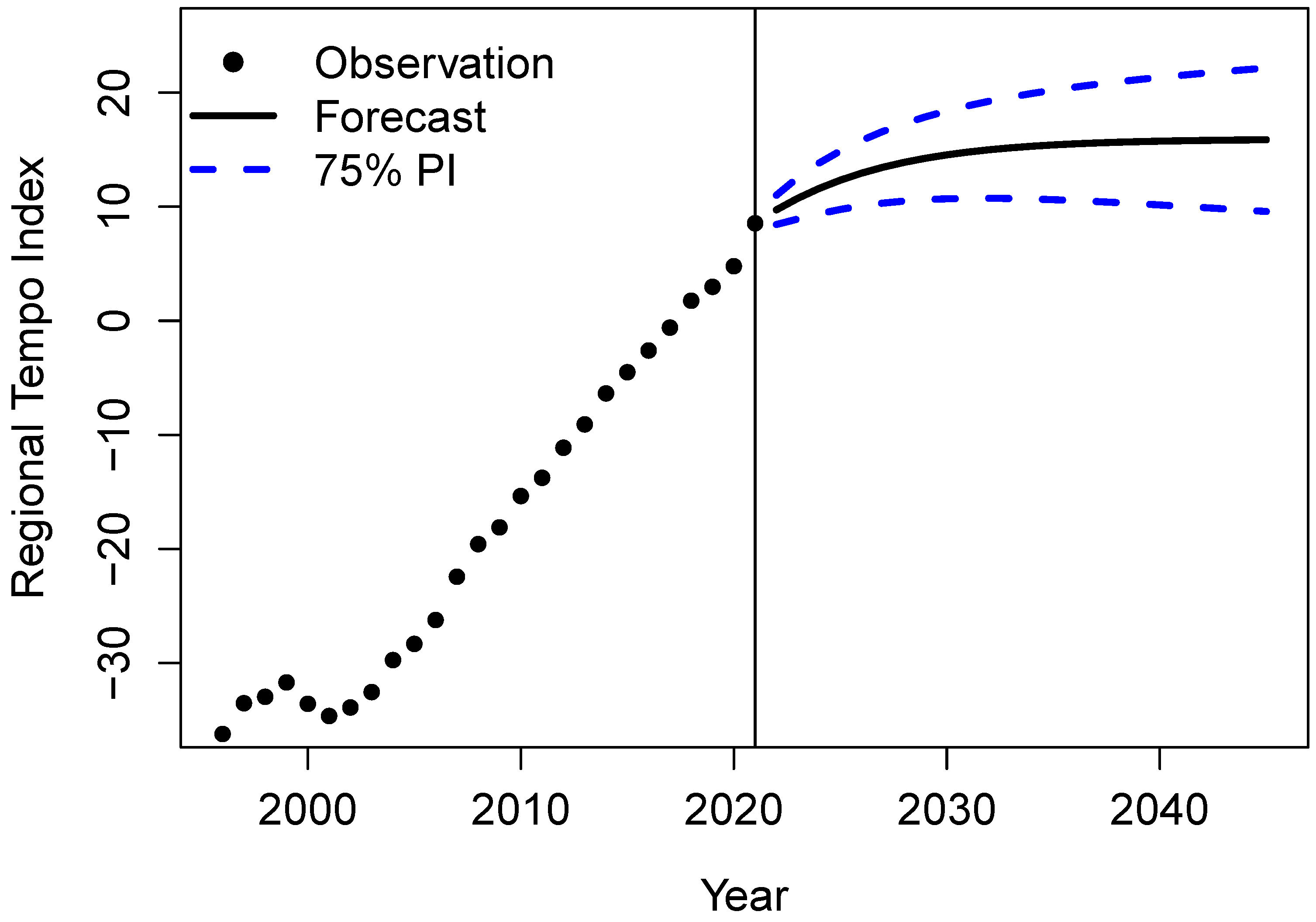
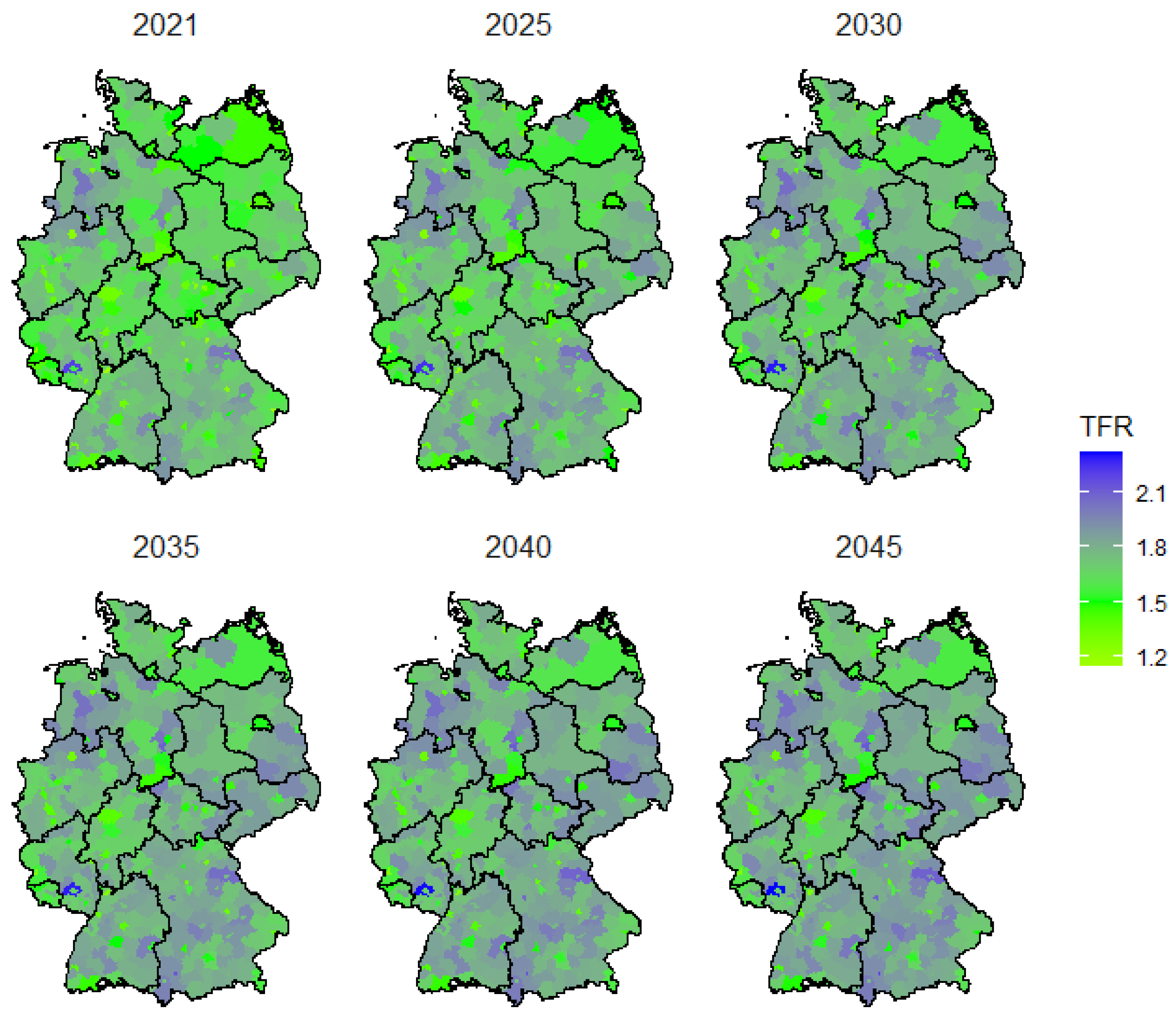
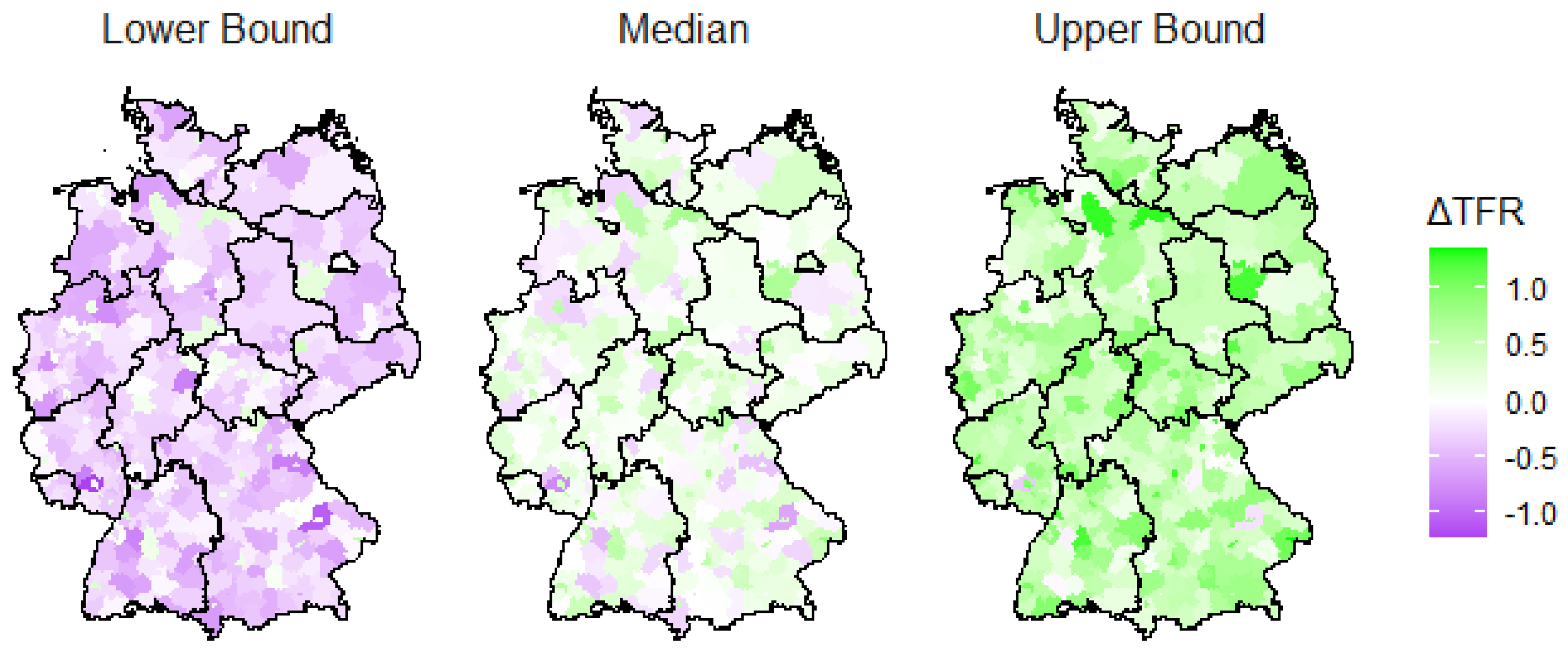
| Principal Component | Individual Share | Cumulative Share |
|---|---|---|
| 1 | 71.1 | 71.1 |
| 2 | 7.7 | 78.8 |
| 3 | 2.9 | 81.8 |
| 4 | 2.0 | 83.7 |
| 5 | 1.1 | 84.8 |
| 6 | 1.1 | 85.9 |
| 7 | 1.0 | 86.9 |
| 8–2370 | <1.0 | 100.0 |
Disclaimer/Publisher’s Note: The statements, opinions and data contained in all publications are solely those of the individual author(s) and contributor(s) and not of MDPI and/or the editor(s). MDPI and/or the editor(s) disclaim responsibility for any injury to people or property resulting from any ideas, methods, instructions or products referred to in the content. |
© 2023 by the authors. Licensee MDPI, Basel, Switzerland. This article is an open access article distributed under the terms and conditions of the Creative Commons Attribution (CC BY) license (https://creativecommons.org/licenses/by/4.0/).
Share and Cite
Vanella, P.; Hassenstein, M.J. Stochastic Forecasting of Regional Age-Specific Fertility Rates: An Outlook for German NUTS-3 Regions. Mathematics 2024, 12, 25. https://doi.org/10.3390/math12010025
Vanella P, Hassenstein MJ. Stochastic Forecasting of Regional Age-Specific Fertility Rates: An Outlook for German NUTS-3 Regions. Mathematics. 2024; 12(1):25. https://doi.org/10.3390/math12010025
Chicago/Turabian StyleVanella, Patrizio, and Max J. Hassenstein. 2024. "Stochastic Forecasting of Regional Age-Specific Fertility Rates: An Outlook for German NUTS-3 Regions" Mathematics 12, no. 1: 25. https://doi.org/10.3390/math12010025
APA StyleVanella, P., & Hassenstein, M. J. (2024). Stochastic Forecasting of Regional Age-Specific Fertility Rates: An Outlook for German NUTS-3 Regions. Mathematics, 12(1), 25. https://doi.org/10.3390/math12010025






